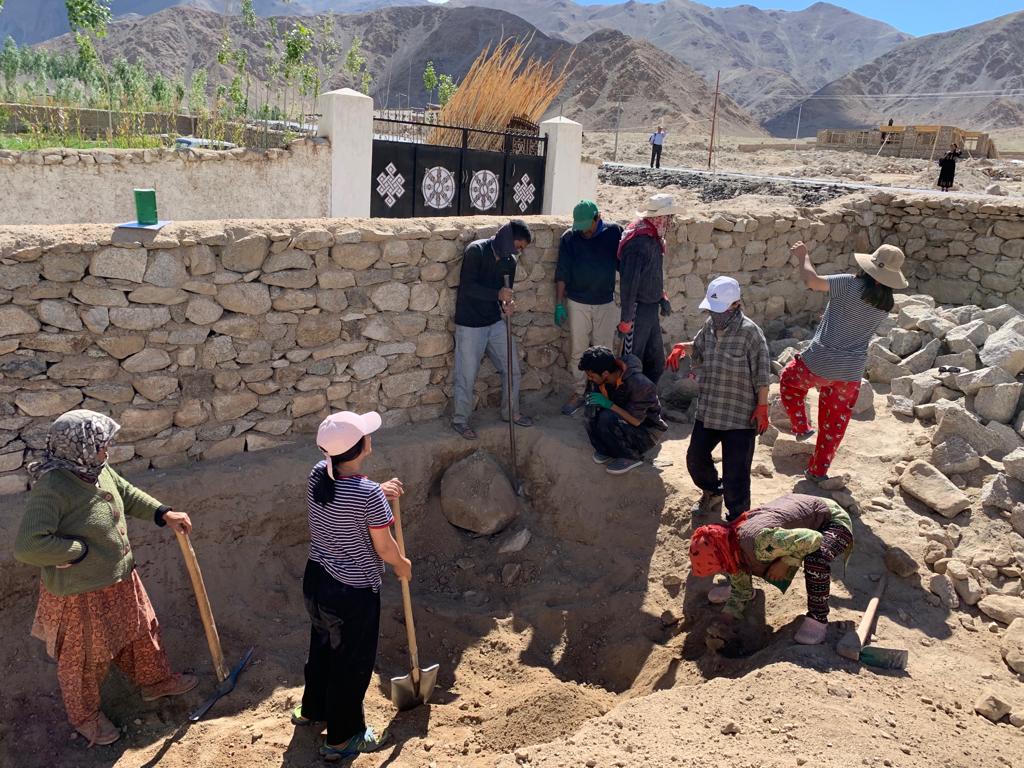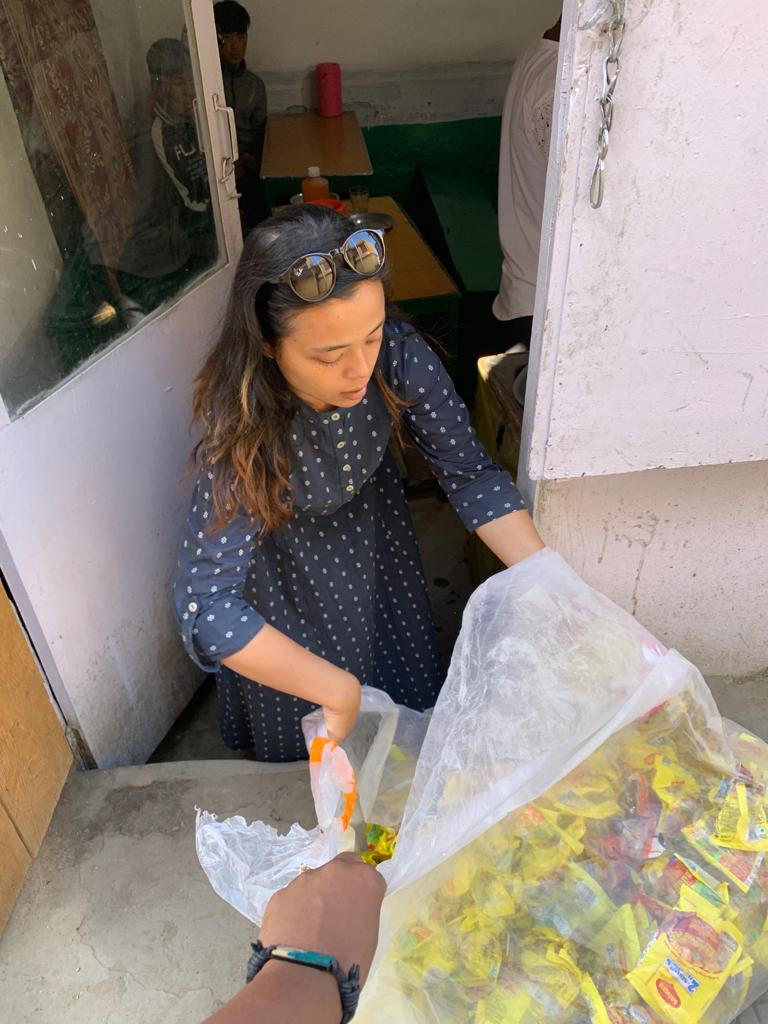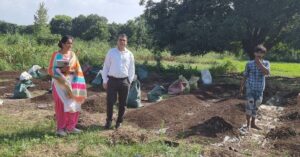Made of Plastic Waste, This Unique Greenhouse Will Help Ladakh Farmers Grow Veggies All Year!
8000 plastic bottles filled with plastic waste is required to make one such greenhouse. Now imagine the volumes of plastic bottles and waste that can be upcycled through this simple technique!

Ladakh, the cold desert of India with its picturesque and stark landscape, is one of the most visited tourist places in the country. Harsh winters make life tough for the populace, 89 per cent of which live in rural areas. Though the cropping season does not last for more than four months, a majority of the people practice farming. It stands to reason then that most of the produce needs have to be sourced from outside. Secondly, thanks to the tourism boom, plastic waste generation is another major issue that the region faces. Linking the two issues, a social enterprise—Agrow—has come up with the solution to construct greenhouses from plastic waste at only Rs 25,000.
Check out this mini hydroponic growing system helps you grow your own vegetables organically, here.
The enterprise is founded by Nischita Bysani from Bengaluru, Shillong-based Akshata Pradhan and Jigmet Singge, a native from Chemrey village, Leh district.
But why greenhouses? The benefits of greenhouse are many including the advantage of growing crops round the year. Growing vegetables in a greenhouse is a very common practice in Ladakh as it does not destroy the production when the temperature drops drastically. According to DRDO-Defence Institute of High Altitude Research, more than 700 greenhouse structures are built every year in Leh district. “In a greenhouse, the crops are grown inside a covered structure that provide favourable climatic conditions throughout the year. The greenhouse captures heat, thus making it possible to grow crops in freezing temperatures,” says Akshata.
How Agrow began
The trio met in September last year through the Naropa Fellowship in Ladakh that aims toward designing cost-effective solutions to socio-economic problems in the region. During the one-year programme, the founders studied the problems persisting in Chemrey village and undertook a comprehensive survey to analyse the possibility of an eco-friendly greenhouse structure in the region. While Nischita, an architect, looked at building an eco-friendly structure to help farmers grow food organically, Jigmet naturally moved toward developing a farming solution that increases food productivity. Meanwhile, Akshata, a postgraduate degree holder in Environmental Science, developed a system where waste could be managed scientifically. Giving highlights about the survey results, 26-year-old Nischita tells The Better India, “Besides being dependent on external sources for their daily supply, the water scarcity and sub-zero temperatures affect people’s diet. They heavily rely on dried vegetables and dry cheese. Most farmers even migrate to urban areas for an extra source of income.” Adding to the observations, Jigmet, who is currently pursuing a Masters in Tourism from The Indira Gandhi National Open University, Delhi, says, “We noticed that several greenhouses built by the government are used as a social space during winters rather than as a greenhouse. This is where we intervene. We will not only install the greenhouse, but we will also provide training on greenhouse agriculture and consistent maintenance checks. The farmer can avail services like drip irrigation and high yielding seeds from us to make sure that the crop will grow well.”
Eco-Friendly, Durable & Cost-Effective Greenhouses
 Agrow uses eco-bricks to build the structure of the greenhouse. These bricks non-biodegradable waste or plastic waste, sand and fodder stuffed in a plastic bottle. Making one one (9×18 ft) greenhouse, requires 8,000 plastic bottles, thus helping in diverting hundreds of kilos of plastic waste from entering landfills. While the first three feet of the structure is made with sand filled plastic bottles, the rest of the structure is made with eco-bricks. “We are using cob plaster (natural earth plaster) to plaster one of the walls. For the remaining sides, we will use 750 ml and one litre bottles. Every side has a double layer to make structure durable. Roofing will be done with wood structures and the south side will be covered with a UV sensitised polythene sheet,” explains Akshata. The construction of the first greenhouse was started last year at Jigmet’s house in Chermey village to be managed by his mother. The structure will have 3,000 bottles that will be filled with sand and 5,000 bottles stuffed with soft plastic waste.
Agrow uses eco-bricks to build the structure of the greenhouse. These bricks non-biodegradable waste or plastic waste, sand and fodder stuffed in a plastic bottle. Making one one (9×18 ft) greenhouse, requires 8,000 plastic bottles, thus helping in diverting hundreds of kilos of plastic waste from entering landfills. While the first three feet of the structure is made with sand filled plastic bottles, the rest of the structure is made with eco-bricks. “We are using cob plaster (natural earth plaster) to plaster one of the walls. For the remaining sides, we will use 750 ml and one litre bottles. Every side has a double layer to make structure durable. Roofing will be done with wood structures and the south side will be covered with a UV sensitised polythene sheet,” explains Akshata. The construction of the first greenhouse was started last year at Jigmet’s house in Chermey village to be managed by his mother. The structure will have 3,000 bottles that will be filled with sand and 5,000 bottles stuffed with soft plastic waste.  The project is being funded by their mentor, Nidhi Reddy. Their model has also been selected by IIT-Mandi incubation centre, “We will get around Rs 1.5 lakhs to make improved versions of the greenhouse,” says Akshata. The greenhouse will be a combination of the passive solar greenhouse and a trench greenhouse. A plastic sheet will act like a solar panel converting the light energy of the sun to heat energy to be absorbed by the soil and plants in the greenhouse. The basic principle of a trench greenhouse, i.e. digging the greenhouse three feet deep, will also be applied, “The north-facing wall will be painted black that absorbs maximum heat and the other walls will be white,” says Nischita. The social enterprise will grow all kinds of leafy vegetables and even hopes to experiment with tomatoes which are highly difficult to grow in a cold terrain. The trio is also experimenting with vertical farming on the walls of greenhouse. As part of phase 1 of the project, Agrow had conducted a massive cleanup drive across Leh and the surrounding villages. A total of 2,500 plastic bottles and other plastic wrappers, plastic bags, and plastic cutlery was collected. The collection drive proved to be an effective way to sensitise the locals and the tourists, “We organised several drives involving schools, locals and even tourists. We tried to spread awareness about the menace of plastic,” informs Jigmet. During the collection, the trio also realised the limitations associated with plastic waste on the dumping grounds, “It is not feasible to use PET bottles if they come in contact with wet waste. Thus, we tied up hotel and restaurants to collect the bottles,” says Jigmet.
The project is being funded by their mentor, Nidhi Reddy. Their model has also been selected by IIT-Mandi incubation centre, “We will get around Rs 1.5 lakhs to make improved versions of the greenhouse,” says Akshata. The greenhouse will be a combination of the passive solar greenhouse and a trench greenhouse. A plastic sheet will act like a solar panel converting the light energy of the sun to heat energy to be absorbed by the soil and plants in the greenhouse. The basic principle of a trench greenhouse, i.e. digging the greenhouse three feet deep, will also be applied, “The north-facing wall will be painted black that absorbs maximum heat and the other walls will be white,” says Nischita. The social enterprise will grow all kinds of leafy vegetables and even hopes to experiment with tomatoes which are highly difficult to grow in a cold terrain. The trio is also experimenting with vertical farming on the walls of greenhouse. As part of phase 1 of the project, Agrow had conducted a massive cleanup drive across Leh and the surrounding villages. A total of 2,500 plastic bottles and other plastic wrappers, plastic bags, and plastic cutlery was collected. The collection drive proved to be an effective way to sensitise the locals and the tourists, “We organised several drives involving schools, locals and even tourists. We tried to spread awareness about the menace of plastic,” informs Jigmet. During the collection, the trio also realised the limitations associated with plastic waste on the dumping grounds, “It is not feasible to use PET bottles if they come in contact with wet waste. Thus, we tied up hotel and restaurants to collect the bottles,” says Jigmet.  The social enterprise has also distributed free jars to vendors selling noodles, a popular snack among the tourists. Once the jar is filled with plastic packets, the enterprise will collect them. The construction of the first greenhouse is underway and locals are hired on volunteering basis to fill the bottles, “It takes almost an hour to fill one bottle. With sufficient manpower, the house can be built within two weeks,” says Akshata. Since most of the materials are sourced locally, the cost of the greenhouse has come down by half. One greenhouse can be built within Rs 25,000. The Way Forward In their next phase, the social enterprise will experiment with microgreens and hydroponic farming to understand the growing requirements. “As an economy generator, we are looking to introduce microgreens to the farmers as there is a rise in demand for the same in urban areas. We will conduct surveys in the market to understand the trends and create the demand for microgreens. We are also looking to approach the Army for a continuous supply to the army bases,” shares Jigmet. In the next year, the social enterprise aims to construct 25 such greenhouses and repurpose hundreds of kilos of plastic waste. “Agrow is more than just about greenhouses. We want to promote the culture of agriculture even during the harshest of winters. This will provide families in Ladakh the much required nutrition in winters without being dependent on outside sources which are expensive and sometimes inaccessible,” says Akshata. The affordable and environment-friendly greenhouse developed by Jigmet, Akshata and Nischita could be an effective solution that tackles two problems in one go. All the images have been sourced from Agrow. You can reach out to Agrow here: [email protected] or click here.
The social enterprise has also distributed free jars to vendors selling noodles, a popular snack among the tourists. Once the jar is filled with plastic packets, the enterprise will collect them. The construction of the first greenhouse is underway and locals are hired on volunteering basis to fill the bottles, “It takes almost an hour to fill one bottle. With sufficient manpower, the house can be built within two weeks,” says Akshata. Since most of the materials are sourced locally, the cost of the greenhouse has come down by half. One greenhouse can be built within Rs 25,000. The Way Forward In their next phase, the social enterprise will experiment with microgreens and hydroponic farming to understand the growing requirements. “As an economy generator, we are looking to introduce microgreens to the farmers as there is a rise in demand for the same in urban areas. We will conduct surveys in the market to understand the trends and create the demand for microgreens. We are also looking to approach the Army for a continuous supply to the army bases,” shares Jigmet. In the next year, the social enterprise aims to construct 25 such greenhouses and repurpose hundreds of kilos of plastic waste. “Agrow is more than just about greenhouses. We want to promote the culture of agriculture even during the harshest of winters. This will provide families in Ladakh the much required nutrition in winters without being dependent on outside sources which are expensive and sometimes inaccessible,” says Akshata. The affordable and environment-friendly greenhouse developed by Jigmet, Akshata and Nischita could be an effective solution that tackles two problems in one go. All the images have been sourced from Agrow. You can reach out to Agrow here: [email protected] or click here.
Also Read: Fresh, Organic & Scrumptious: Why Ladakh is Home to The World’s Sweetest Apricots!
(Edited by Saiqua Sultan)
Like this story? Or have something to share? Write to us: [email protected] Connect with us on Facebook and Twitter.
If you found our stories insightful, informative, or even just enjoyable, we invite you to consider making a voluntary payment to support the work we do at The Better India. Your contribution helps us continue producing quality content that educates, inspires, and drives positive change.
Choose one of the payment options below for your contribution-
By paying for the stories you value, you directly contribute to sustaining our efforts focused on making a difference in the world. Together, let's ensure that impactful stories continue to be told and shared, enriching lives and communities alike.
Thank you for your support. Here are some frequently asked questions you might find helpful to know why you are contributing?


This story made me
-
97
-
121
-
89
-
167














